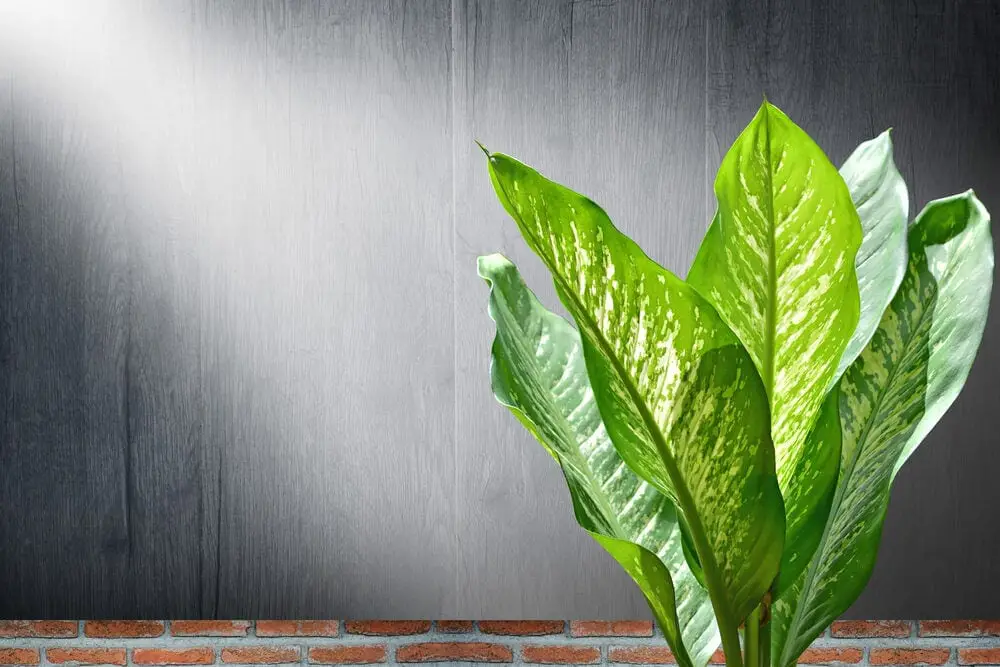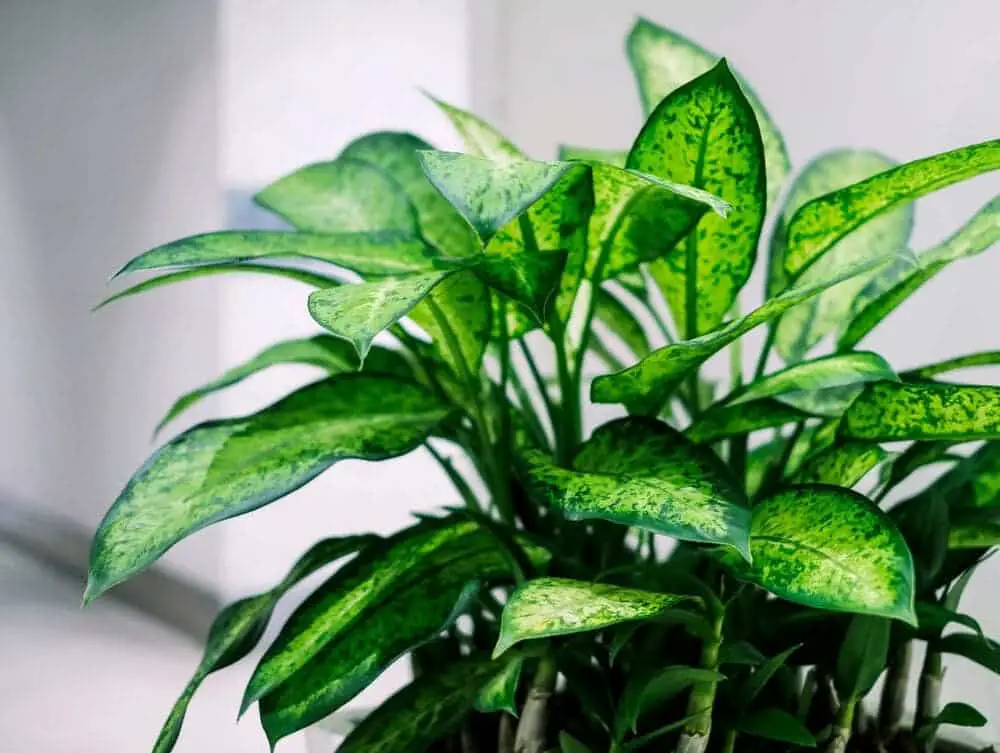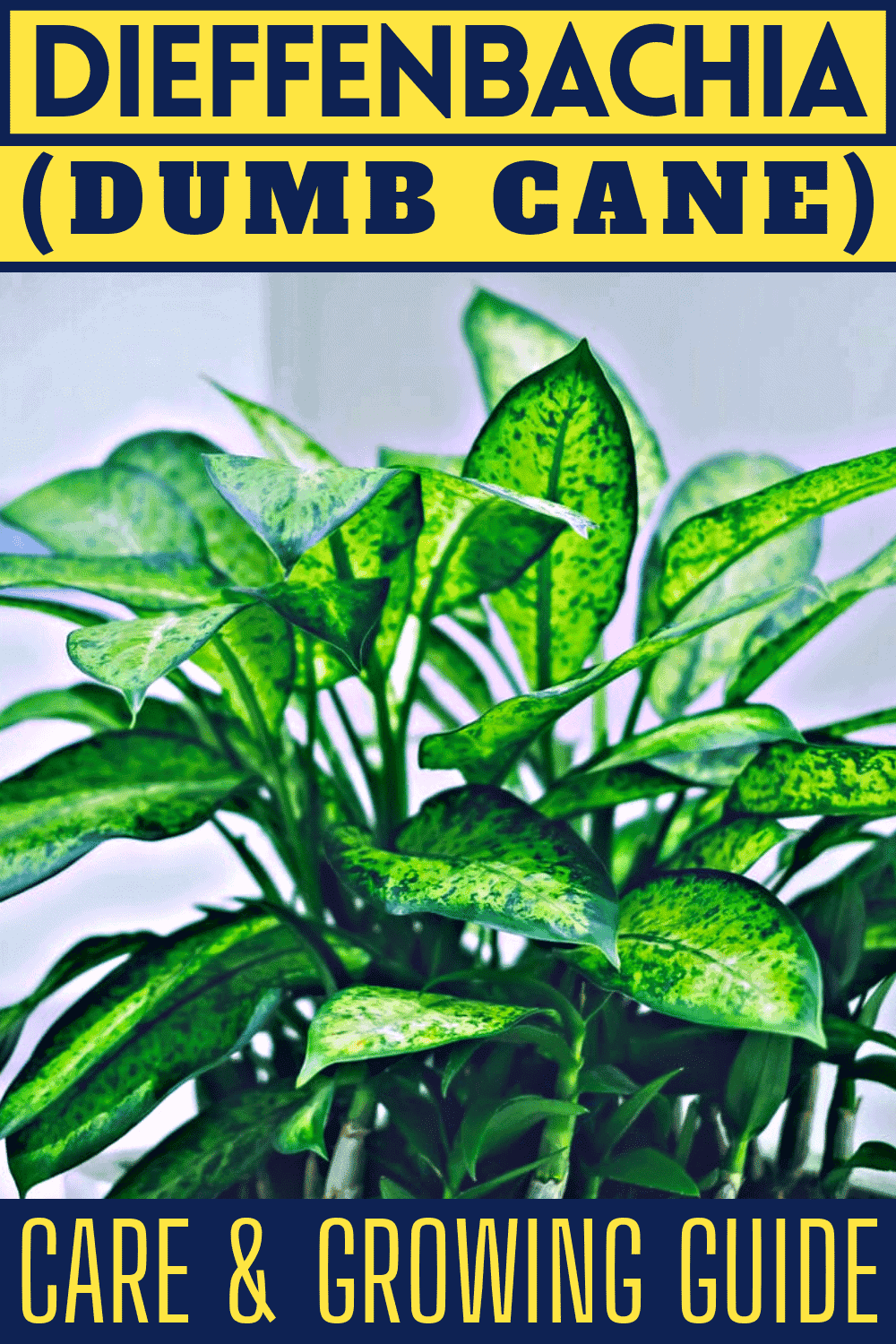This hardy, medium-sized plant has a bad reputation as a poisonous plant.
But it is an excellent house plant with marbled green and white leaves.
Dumb Cane Care & Growing Guide
1. Light Requirement
The dieffenbachia needs bright indirect light, whether it is indoors or outdoors. Do not keep it in either the shade or in direct sunlight. It can get a few hours of the morning sun, but by noon, it should be under a shelter or inside your home if it receives too much light, the leaves will begin to curl and scorch. If it doesn’t receive enough light, the plant will not grow and look very sickly.
2. Water
The dieffenbachia likes to be watered thoroughly, but it should dry out before the next watering. In the summer months, water this plant more often. In the winter, cut back on watering it.
3. Climate and temperature
Humility is essential to this plant. If the moisture in the air drops too low, the plant will suffer, and the leaves will wither and droop. It also loves warm air. If the temperature drops below 60F, you will see the plant turn sickly. Keep it between 60F and 80F. Do not place this plant by drafty, cold windows. If you do, the leaves will become yellow and fall off. This plant does best in hardiness zones 11 and 12.
4. Soil
The soil for this plant must be well-draining and fertilized. This plant takes up a lot of nutrients, so you may have to feed it every six weeks. Make sure to keep the soil soaked, then let it dry out. If the ground you want to plant it in is too coarse or compact, you can add peat or perlite to improve drainage.
5. How to repot the Dieffenbachia
During the Spring, check out the roots in the container. If they’re too crowded, it needs to be in a bigger sized pot. Do not water it one or two weeks before repotting. Once you repot it, water it until the soil is damp.

6. Speed of Growth
Depending on how much sun and moisture it receives, this plant can grow from moderately to very quickly. The faster it grows, the more you’ll have to trim it. Light also plays a significant factor in the speed at which it grows.
7. Height and Width of the plant
The height of the dieffenbachia is relative to how long its roots are. If its roots are in the ground, it can grow around 5 feet tall. But if it’s in a container, expect it to be around two feet or the size of its container. The Wits of the dieffenbachia is about 18 inches to two ft depending on how spread out the leaves are.
8. Trimming
You must regularly trim this plant if you don’t want it to grow too large, especially if it is indoors. First, start with the largest leaves so that the smaller leaves can Grill better. When you cut a leaf off, cut it just before a node so that the baby leaves can grow from the node.
How do I propagate the Dieffenbachia?
You can propagate the dieffenbachia by cutting stems that are growing on the sides of the plant and from the root ball. Keep the baby plants in moist sand until the roots grow strong and then transfer them to a container with potting soil.
Is the Dieffenbachia Poisonous?
Yes, this plant is known for being poisonous. However, it’s poison is not strong enough to kill humans or animals. The poison comes from microscopic needles all over the plant that injects poison into whoever is eating it. Poison symptoms include swelling, inability to talk, and a painful mouth. You should not have this plant if you have small children or animals.
Can Dieffenbachia grow in Water?
Yes, if you take a cutting and root it in water, it will be acclimated to grow in water. To make this happen, cut a stem that is 4 to 6 inches long and then remove all of the leaves. Then place the cutting in water and put it by a window sill. Don’t remove the cutting until it has formed long roots in the water. When the roots are long, you can either repot this plant in soil or continue to grow this plant hydroponically in water.

Does this plant have flowers and how to get to Flower?
Yes, but it’s flowers are not as pretty as its leaves are. The flowers are dull green with a white middle. The flowers are in the center of the plant. It can also develop a berry-like fruit. If the dieffenbachia is outside, then you can make the flower bloom by providing it with a lot of direct light and keeping the ground moist and fertilized. If it’s indoors, then the chances of it blooming are scarce.
Common Dieffenbachia Diseases
Brown leaves
If your dieffenbachia is experiencing brown leaves, it means you are using too much fertilizer or plant food in its potting soil or in the ground. Overfertilization usually happens in the winter, When there’s less water to drain it away from the soil. Stop adding fertilizer to the plant for a while.
Red spider mites
Red spider mites attack plants when the weather is high hot and very dry. If you have an indoor plant, they’re more likely to get it then outdoor plants. You can tell you have a red spider mite problem when the leaves of your plants have small yellow or white dots, and then they turn yellow. There will also be small patches of webs around your plant.
To get rid of red spider mites, introduce ladybugs into your garden because ladybugs are there natural predators. Or you can rise off the bugs, and then spray neem oil over the plant. The neem oil is an irritant, and the mites will stay away.
Also read:
Conclusion
- This plant is also called the leopard lily
- It loves humidity and warmth
- Although it does have a flower, the flower is not very pretty. But it can produce berries.
- Keep its soil moist and then let it dry before it is watered.
- This plant can grow hydroponically if it is grown from a stem cutting.
- Don’t fertilize it in the winter.

Victoria is the owner and main author of hobby plants. She loves spending her free time in her garden planting and taking care of her plants. Victoria hopes you enjoy the content here!
![Yucca Cane Plant Care: [Complete Beginner's Guide] Yucca Cane Plant Care: [Complete Beginner's Guide]](https://www.hobbyplants.com/wp-content/uploads/2022/09/yucca-cane-plant-care-300x158.jpg)
![Mother Of Thousands Plant [Complete Plant Care Guide] Mother Of Thousands Plant [Complete Plant Care Guide]](https://www.hobbyplants.com/wp-content/uploads/2022/07/mother-of-thousands-plant-300x158.jpg)
![How Often Should You Water Pothos? [Complete Care Guide] How Often Should You Water Pothos? [Complete Care Guide]](https://www.hobbyplants.com/wp-content/uploads/2022/07/how-often-to-water-pothos-300x158.jpg)
![Can Snake Plants Live Outside? [COMPLETE CARE GUIDE] Can Snake Plants Live Outside? [COMPLETE CARE GUIDE]](https://www.hobbyplants.com/wp-content/uploads/2022/08/can-snake-plants-live-outside-300x158.jpg)
![Majesty Palm Plant Care: [Complete Beginner's Guide] Majesty Palm Plant Care: [Complete Beginner's Guide]](https://www.hobbyplants.com/wp-content/uploads/2022/08/majesty-palm-care-300x158.jpg)
![Exotic Angel Plant Care: [Complete Beginner's Guide] Exotic Angel Plant Care: [Complete Beginner's Guide]](https://www.hobbyplants.com/wp-content/uploads/2022/08/exotic-angel-plant-care-300x158.jpg)
![Do Coleus Like Sun Or Shade: [Complete Care Guide] Do Coleus Like Sun Or Shade: [Complete Care Guide]](https://www.hobbyplants.com/wp-content/uploads/2022/08/coleus-sun-or-shade-300x158.jpg)
![Snow White Waffle Plant: [Complete Care Guide] Snow White Waffle Plant: [Complete Care Guide]](https://www.hobbyplants.com/wp-content/uploads/2022/08/snow-white-waffle-plant-300x158.jpg)
![Waffle Plant Care: [Complete Beginner's Guide] Waffle Plant Care: [Complete Beginner's Guide]](https://www.hobbyplants.com/wp-content/uploads/2022/08/waffle-plant-300x158.jpg)
![Bird Of Paradise Plant Care: [Complete Beginner's Guide] Bird Of Paradise Plant Care: [Complete Beginner's Guide]](https://www.hobbyplants.com/wp-content/uploads/2022/08/bird-of-paradise-plant-300x158.jpg)
![Purple Passion Plant Care: [Complete Beginner's Guide] Purple Passion Plant Care: [Complete Beginner's Guide]](https://www.hobbyplants.com/wp-content/uploads/2022/08/purple-passion-plant-care-300x158.jpg)
![China Doll Plant Care: [Complete Beginner's Guide] China Doll Plant Care: [Complete Beginner's Guide]](https://www.hobbyplants.com/wp-content/uploads/2022/09/china-doll-plant-care-300x158.jpg)